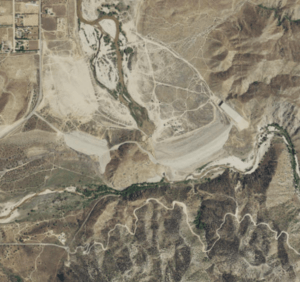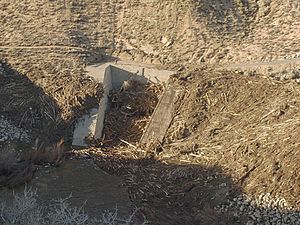Mojave Forks Dam facts for kids
Quick facts for kids Mojave Forks Dam |
|
|---|---|

Satellite view, showing the main dam and spillway to the right, and auxiliary dam to the left. The Mojave River flows north (up) downstream of the dam.
|
|
|
Location of Mojave Forks Dam in California
|
|
| Country | United States |
| Location | Hesperia, California |
| Coordinates | 34°20′36″N 117°14′03″W / 34.34333°N 117.23417°W |
| Purpose | Flood control |
| Construction began | 1967 |
| Opening date | 1974 |
| Owner(s) | |
| Dam and spillways | |
| Type of dam | Rolled earthfill embankment |
| Impounds | Mojave River |
| Height | 193 ft (59 m) |
| Length | 2,223 ft (678 m) |
| Reservoir | |
| Creates | Mojave River Forks Reservoir |
| Total capacity | 179,400 acre⋅ft (221,300,000 m3) |
| Catchment area | 215 sq mi (560 km2) |
The Mojave Forks Dam, also called the Mojave River Dam, is a large earth-fill dam. It crosses the Mojave River in San Bernardino County, California, in the United States. This dam is a "dry dam," which means it usually doesn't hold water. It only fills up when there's a lot of rain.
The U.S. Army Corps of Engineers (USACE) finished building it in 1974. The dam is located where the West Fork Mojave River and Deep Creek meet. It can hold about 179,400 acre⋅ft (221,300,000 m3) of water, which is a huge amount! Its main job is to control floods.
Contents
Building the Mojave Forks Dam
Why the Dam Was Needed
People first thought about building a dam at the Mojave River forks way back in 1875. In the 1930s, big floods showed how much a dam was truly needed. These floods caused a lot of damage along the Mojave River.
Construction and Completion
It took many years for the state to agree to the project. Finally, in 1960, the plan for the West Fork Flood Control and Reservoir Project was approved. The U.S. Army Corps of Engineers designed the dam by 1966.
Construction started in June 1967. The main part of the dam was finished in May 1971. The entire project was officially completed and ready to work by 1974.
Keeping the Dam Safe
Engineers regularly check the dam's safety. In 2019, they looked at the dam to make sure it met national safety rules. These checks help ensure the dam stays strong and safe, even during very big floods.
How Big is the Dam?
Size and Materials
The Mojave Forks Dam is 193 feet (59 m) tall above the riverbed. That's about as tall as a 19-story building! It is also 2,223 feet (678 m) long. The main part of the dam is made from rolled earthfill. This means it's built with layers of tightly packed dirt and rocks. It contains a massive 5,310,000 cubic yards (4,060,000 m3) of material.
Parts of the Dam
There is a smaller dam, called an auxiliary dam, just west of the main dam. On the east side, you'll find the concrete spillway. A spillway is like a giant overflow channel. It helps release extra water safely when the reservoir gets too full.
Where the Water Comes From
The dam controls water from a rugged area of 215 square miles (560 km2). This area is called a drainage basin, which is like a big bowl where all the rain and snow melt collect. This basin is on the north side of the San Bernardino Mountains.
Even though the entire Mojave River basin is much larger, this smaller area behind the dam provides most of the water. The dam helps protect towns like Victorville, Hesperia, and Barstow from floods.
How the Dam Works
Flood Control in Action
The Mojave Forks Dam is used only for flood control. This means the reservoir behind it is usually empty or has very little water. But after heavy winter storms, it can fill up quickly.
When the reservoir fills, the dam releases the floodwaters slowly. It lets out just enough water so that the river downstream doesn't overflow its banks. This protects homes and businesses.
Special Outlet Design
Unlike many dams, the Mojave Dam's outlet has no gates. This means the amount of water flowing out depends directly on how much water is in the reservoir. If there's a small amount of water, it flows through easily. If there's a lot, more water flows out.
The dam is built to handle huge floods, letting out water at a controlled rate. Usually, the reservoir drains completely within 2 to 3 days after a flood.
Helping Groundwater
The dam also has a hidden benefit. By slowing down flash floods, it helps the ground soak up more water. This is called groundwater recharge. It helps refill the underground water supply in the Victor Valley area, which is important for drinking water and farming.
Fun at Mojave Forks Dam
Mojave River Forks Regional Park
Even though there's no permanent lake at the dam, the area is part of the Mojave River Forks Regional Park. This park is a great place for outdoor activities.
You can go camping there, enjoying nature under the stars. There are also hiking trails for exploring the beautiful landscape.
The Pacific Crest Trail
The famous Pacific Crest Trail also passes by the dam. This long-distance hiking trail runs parallel to the eastern side of the dam. Hikers on the trail travel between the valleys of Deep Creek and the West Fork Mojave River.



